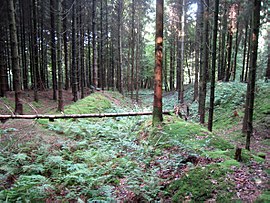Schnepfenthal mine
| Schnepfenthal mine | |||
|---|---|---|---|
| General information about the mine | |||
| Pingen and small heaps of the Schnepfenthal mine | |||
| Mining technology | Civil engineering | ||
| Information about the mining company | |||
| Start of operation | 1854 | ||
| End of operation | 1909 | ||
| Funded raw materials | |||
| Degradation of | Lead , copper , iron | ||
| Geographical location | |||
| Coordinates | 50 ° 55 '58.3 " N , 7 ° 14' 37.4" E | ||
|
|||
| Location | Hope valley | ||
| local community | Rösrath | ||
| ( NUTS3 ) | Rheinisch-Bergischer Kreis | ||
| country | State of North Rhine-Westphalia | ||
| Country | Germany | ||
| District | Bensberg ore district | ||
The Schnepfenthal mine is a former non-ferrous metal ore mine in the Bensberg ore district in Rösrath . It was north of the village of Boddert near Bleifeld .
history
On January 30, 1854, Wilhelm Schönenborn from Heiligenhaus submitted a request for encouragement under the name Wilhelm on Spateisenstein and lead ore . A repeated request for speculation dates from July 27, 1854. On July 27, 1855, he speculated again, namely for copper , lead and zinc ores as well as Spateisenstein. A field inspection of the Mutung with the new name Wilhelm modo Schönenborn took place on July 4, 1857. On May 29, 1858 it was mentioned with the name Grube Schönenborn . The award as Längenfeld on iron, copper and lead took place on September 19, 1858 with the name Schnepfenthal to Wilhelm Schönenborn.
Obviously he then sold the mine, because the businessman Heinrich Schüchtermann from Dortmund applied for an expansion on October 25, 1865, on the basis of which the Schnepfenthal mine on August 22, 1867 as a square in the communities of Löderich, Bleifeld, Honrath and Heiliger on iron , Lead and copper ores were awarded. Schüchtermann sold the Schnepfenthal mine on July 31, 1869 to the Phönix company for mining and smelting operations in Laar in Duisburg . With a presumption of February 28, 1871, the award of the field to zinc ore was sought. After a field inspection on July 5, 1871, the building worthiness was positive, zinc ores were awarded on July 20, 1871. In March 1873, a steam boiler was installed for the extraction. Nothing is known about the further operation.
An annual report for 1909 mentions five workers, the tunnels aufgewältigt Büchel and through a die of 20 meters depth have been studied. Spateisenstein and brown ironstone were found up to a meter thick . Further information is not available. Records indicate that 16,500 tons of Spateisenstein, 12 quintals of Blende, 21 quintals of lead ores and 150 quintals of copper ores were mined here.
literature
- Harald Bertsch: Daelhusen, the story of Dahlhaus and the land between Agger and Sülz . here: The Schnepfenthal mine pp. 130-133, Lohmar 2015, ISBN 978-3-939829-56-0 .
Individual evidence
- ↑ a b Herbert Stahl (editor): Das Erbe des Erzes, Volume 5, New news and stories about the ore district of Bensberg , Bergisch Gladbach 2014, ISBN 978-3-00-044826-3 , p. 40 f.
- ↑ The word modo means something like new, changed, recently .
- ↑ Daelhusen: The story of Dahlhaus and the land between Agger and Sülz

